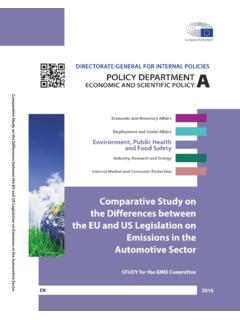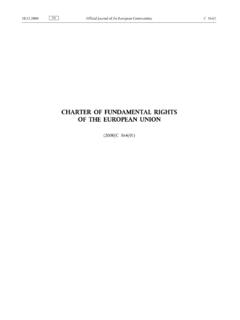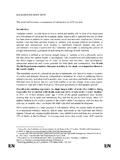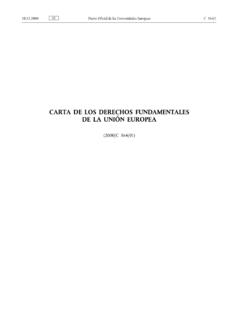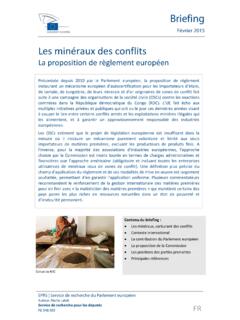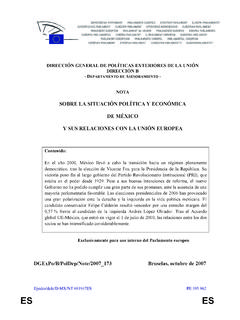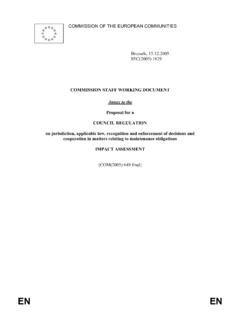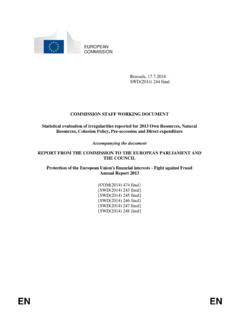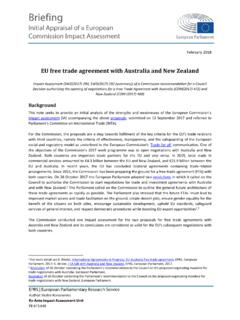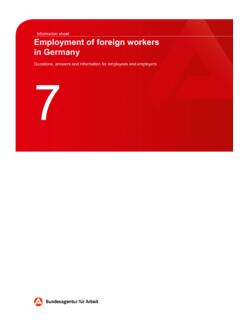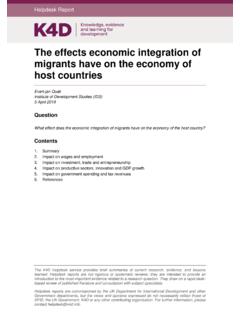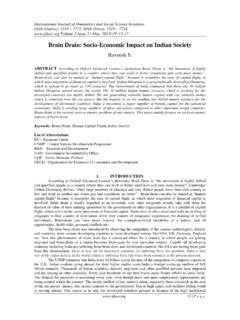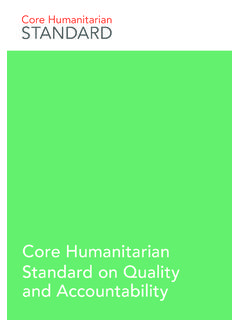Transcription of Migrant seasonal workers in the European agricultural sector
1 BRIEFING EPRS | European Parliamentary Research Service Author: Marie-Laure Aug re-Granier Members' Research Service PE February 2021 EN Migrant seasonal workers in the European agricultural sector SUMMARY The EU fruit and vegetable sector is heavily dependent on a non-national labour force, either from other EU Member States or third countries. Germany, Italy, Spain, France and Poland, in particular, employ high numbers of Migrant seasonal farm workers . While these numbers have been steadily increasing, they compensate only partly for the ongoing decline in national agricultural workforces.
2 Migrant seasonal workers from the EU are entitled to fully equal treatment with nationals of the host country under the fundamental right to the free movement of workers within the EU, whereas third-country nationals are covered by the seasonal workers Directive of 2014, which grants them equal treatment as regards terms of employment and some social benefits. EU Member States manage their own seasonal worker schemes depending on the needs of the domestic labour market, their ties with third countries and their broader immigration system.
3 The reality of seasonal agricultural work is a harsh one, with generally poor working and living conditions. Undocumented migrants , but also legal ones, can fall victim to illegal gang-master practices or even modern forms of slavery. Exploitation of women occurs in certain regions. The coronavirus pandemic, which disrupted harvests in the spring of 2020 as seasonal workers faced travel restrictions, also highlighted their essential role in EU agriculture and laid bare their sometimes appalling working and living conditions.
4 Reacting to this situation, the European Parliament adopted a resolution on the protection of seasonal workers in June 2020, calling on Member States to ensure proper implementation of the relevant EU legislation and on the European Commission to issue new specific guidelines and propose long-term solutions to fight abusive practices and protect victims. In July 2020, the Commission responded to this call by issuing new guidelines on the protection of seasonal workers in the context of the pandemic, announcing further action, including ongoing work with the European Labour Authority.
5 IN THIS BRIEFING Introduction seasonal agricultural workers in the EU: facts and figures Overview of the EU legal framework National seasonal worker schemes The harsh reality of seasonal farm work Disruption of the EU fruit and vegetable sector by the pandemic EU action to protect Migrant seasonal workers during the pandemic EU institutions' views EPRS | European Parliamentary Research Service 2 Introduction In the first quarter of 2020, the coronavirus pandemic that hit the EU and the rest of the world triggered restrictions on Migrant worker mobility within the EU and from third countries.
6 Many Member States, in an attempt to contain and halt the spread of the virus, adopted extraordinary measures such as border controls and closures, travel restrictions, lockdowns or temporary suspension of new immigration and asylum applications. At EU level, on 17 March 2020, the EU Heads of State or Government decided to close the European Union's external and Schengen borders for 30 days. These restrictive measures disrupted traditional labour flows in critical sectors of the economy that are heavily dependent on Migrant labour, in particular agriculture.
7 Several EU countries faced a severe shortage of foreign labour in their agricultural sectors, at a time when their presence was critical to ensure the harvest of spring fruit and vegetables. There was a risk of disruption in the food chain and shortage of certain agricultural goods in shops, while farmers saw entire crops wasted. For Migrant workers and their families, this meant the inability to earn a living abroad. The situation triggered urgent measures at EU and national level to allow the free movement of Migrant seasonal workers , and the crisis shed light on the critical role of seasonal agricultural workers in EU agriculture and in ensuring food supply continuity.
8 The crisis also put the spotlight on Migrant farm workers ' often difficult and precarious working and living conditions. Coronavirus clusters developed among them, drawing attention to this category of worker and exposing cases of exploitation and modern slavery. seasonal agricultural workers in the EU: Facts and figures European farming and the need for seasonal labour Farming is by definition a seasonal activity, with production peaks at certain times of the year. Certain farm sectors, such as the fruit and vegetable sector , are very labour-intensive, meaning that tending, harvesting and packaging require high numbers of agricultural workers for a limited duration.
9 This work used to be done by the farmers themselves, but the ongoing process of consolidation in EU agriculture has resulted in fewer and larger farms, with hired workers doing an ever increasing share of farm work. According to a report by the International Labour Organization (ILO) on Migrant workers in commercial agriculture, hired workers do most of the harvest work on farms that produce fruit, horticultural and vegetable commodities in western European countries. A significant share of them are migrants , from the EU and beyond.
10 They sustain labour-intensive crop production in high-income countries and in some cases enable its expansion. Overview of migration flows of seasonal agricultural workers Among European countries employing high numbers of Migrant agricultural workers , Germany and the United Kingdom tend to recruit seasonal labour from other European Member States. Germany receives around 300 000 workers a year for agricultural , horticultural and forestry work, many of them from Central and Eastern Europe, especially Poland and Romania.
